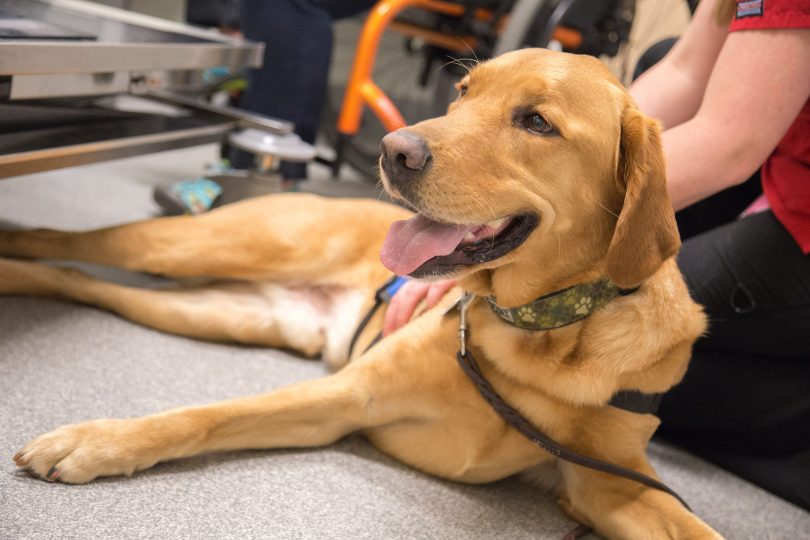Dr. Kate Creevy was just beginning her career as a small animal veterinary faculty member at the University of Georgia College of Veterinary Medicine when she was approached by Daniel Promislow. Promislow, a faculty member in the Department of Genetics in the Franklin College of Arts and Sciences at UGA, had been running a lab studying fruit flies and was intrigued by an article on the genetics of size in dogs. He wondered, why do smaller dogs live longer lives than their larger counterparts?
Together, the two began to form the basis of what has become the Dog Aging Project. And as a partner institution alongside six other colleges of veterinary medicine around the country, researchers at the University of Georgia are looking for new participants in the study.
There are almost 90 million dogs living in the United States, and to date, nearly 30,000 dog owners from around the country have volunteered for this community science research project dedicated to understanding the biological and environmental determinants of canine aging as part of a five-year, $23 million project funded by the National Institute on Aging, a part of the National Institutes of Health.
“By summer 2021, we’re hoping to have 60,000 pack members eligible for additional studies. These animals bring so much to our lives. Our entire team is dedicated to extending quality of life into advanced age for dogs and their humans,” said Creevy, DAP chief veterinary officer and, now, associate professor in the College of Veterinary Medicine and Biomedical Science at Texas A&M University.
A select number of enrollees will also be eligible to participate in a clinical trial of the drug rapamycin. UGA cardiologist and associate professor of small animal medicine and surgery Dr. Mandy Coleman is helping to lead the trial nationwide.
Rapamycin is an immunosuppressant used in humans to combat transplanted organ rejection and some types of cancer. But scientists at the Dog Aging Project believe that it can be beneficial in prolonging healthy heart functions in dogs—effectively increasing their “healthspan,” or the time in life that a patient is most active, healthy and free of disease.
“This trial is truly unique in its goal and its breadth, and it’s mutually beneficial for dogs and human beings,” said Coleman. “As veterinarians, testing the effects of rapamycin in dogs is attractive, because the findings will be directly applicable to our patients and represent an opportunity to have healthier, happier patients for longer than we do today. However, this work can also impact human health. People and companion dogs share a common environment, so they experience many of the same environmental aging factors daily. Our findings could have a major impact on how we view and approach aging in both species.”
All kinds of dogs are welcome to join, but researchers are specifically seeking dogs, both purebred and mixed breed, in the following categories:
Breeds
- Large breed dogs weighing between 70-100 pounds, especially breeds other than Labradors, golden retrievers and German shepherds (the most common breeds in the U.S.)
- Giant breed dogs weighing more than 100 pounds, such as Great Danes, wolfhounds and mastiffs
- Hound dogs, spaniels, pointers, terriers, bulldogs and pit bulls (purebred and mixed breed)
- Working dogs, such as herding, K9 and service dogs
Geographical regions
- Dogs living in rural areas, small towns and large cities
- Dogs in the Athens area will be considered for an upcoming clinical trial
“Healthy aging is the result of both genetics and the environment. It’s really important for us to study dogs who live in all kinds of environments from farm dogs to city dogs. Right now, we are specifically recruiting dogs from areas where we don’t have as many participants as we’d like to—like this one!” explained Promislow, DAP principal investigator and co-director, now a professor at the University of Washington
Puppies
Because the DAP is a long-term study, puppy participants are especially beneficial to the project. The research team wants to follow dogs through their entire lives.
“Better understanding the health effects of the presence and timing of spaying and neutering your dogs is of particular interest to the veterinary community,” explained Creevey. “Following puppies through the process of spaying or neutering or through reproductive activity will tell us a lot about how these events influence healthy aging.”
Joining the pack
To participate in the Dog Aging Project, owners nominate a dog (one per household) at the project website, DogAgingProject.org. After this, they are invited to set up a personal research portal where they answer scientific surveys about their dog and upload veterinary records.
As a member of the Dog Aging Project Pack, participants will be asked to complete an annual health survey about their dog, which will take two to three hours, and several other shorter surveys (estimated 10-30 minutes each) spread throughout the year.
Once a dog is a member of the Dog Aging Project Pack, they may be eligible for a variety of other research activities (all voluntary), which could include genetic analyses, the collection of biological samples, or even participation in a clinical trial.
The Dog Aging Project is supported by the National Institutes of Health’s National Institute on Aging, grant 5U19AG057377-03.
For more information, or to nominate your dog, visit dogagingproject.org.








